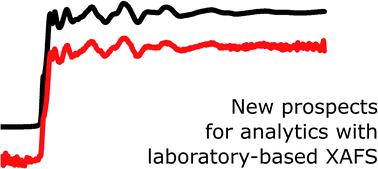当前位置:
X-MOL 学术
›
J. Anal. At. Spectrom.
›
论文详情
Our official English website, www.x-mol.net, welcomes your
feedback! (Note: you will need to create a separate account there.)
Recent progress in the performance of HAPG based laboratory EXAFS and XANES spectrometers
Journal of Analytical Atomic Spectrometry ( IF 3.1 ) Pub Date : 2020-07-15 , DOI: 10.1039/d0ja00208a Christopher Schlesiger 1, 2, 3, 4 , Sebastian Praetz 1, 2, 3, 4 , Richard Gnewkow 1, 2, 3, 4 , Wolfgang Malzer 1, 2, 3, 4 , Birgit Kanngießer 1, 2, 3, 4
Journal of Analytical Atomic Spectrometry ( IF 3.1 ) Pub Date : 2020-07-15 , DOI: 10.1039/d0ja00208a Christopher Schlesiger 1, 2, 3, 4 , Sebastian Praetz 1, 2, 3, 4 , Richard Gnewkow 1, 2, 3, 4 , Wolfgang Malzer 1, 2, 3, 4 , Birgit Kanngießer 1, 2, 3, 4
Affiliation

|
New developments in the description and modeling of Highly Annealed Pyrolytic Graphite (HAPG) mosaic crystals have led to the possibility of designing optimized optical solutions for X-ray absorption fine structure (XAFS) spectroscopy. XAFS is a very versatile method that is usually divided into two sub methods: extended X-ray absorption fine structure (EXAFS) and X-ray absorption near edge structure (XANES) spectroscopies, which need different experimental conditions concerning spectral resolving power, energetic bandwidth and number of detected photons. For facilitating XANES and EXAFS spectroscopies with laboratory- and von Hamos-based spectrometers, tailored optics were designed as well as optimized spectrometer components, i.e. an adequate microfocus X-ray source and a pixelated detector, were chosen. This is shown with a demonstration experiment on pure copper foil. In the XANES case a spectral resolving power of E/ΔE ≈ 4000 and an energy bandpass of around 300 eV were achieved with a measurement time of t = 7 min. For EXAFS, the tailored optic has an increased solid angle at moderate spectral resolving power in combination with a large energy bandpass of over 1 keV and a measurement time of t = 250 s for the given copper foil. These optimized solutions pave the way to perform XANES and EXAFS in the laboratory even for diluted samples with analyte concentrations of only a few weight percent or even less in a reasonable time frame of minutes to hours. Spectrometers, that already had an impact on research, especially catalysis research, therefore, made a huge leap in efficiency that prepares them to meet new challenges, not only as a standalone method, but also in combination with high-end synchrotron radiation facility-based XAFS experiments.
中文翻译:

基于HAPG的实验室EXAFS和XANES光谱仪性能的最新进展
在高度退火的热解石墨(HAPG)镶嵌晶体的描述和建模方面的新发展,导致有可能为X射线吸收精细结构(XAFS)光谱设计优化的光学解决方案。XAFS是一种非常通用的方法,通常分为两个子方法:扩展的X射线吸收精细结构(EXAFS)和近边缘结构的X射线吸收光谱(XANES)光谱,这需要有关光谱分辨能力,高能带宽的不同实验条件和检测到的光子数。为了便于实验室和基于von Hamos的光谱仪进行XANES和EXAFS光谱分析,设计了量身定制的光学器件以及优化的光谱仪组件,即选择了足够的微焦点X射线源和像素化检测器。纯铜箔上的演示实验表明了这一点。在XANES箱子的光谱分辨能力ë /Δ ë ≈4000和电子伏特的约300的能量带通用的计测时间达到吨= 7分钟。对于EXAFS,量身定制的光学器件在中等光谱分辨能力下具有增加的立体角,并结合了超过1 keV的大能量带通和t的测量时间对于给定的铜箔= 250 s。这些优化的解决方案为在实验室中进行XANES和EXAFS铺平了道路,即使是在几分钟到几小时的合理时间内,对于分析物浓度仅为几%甚至更低的稀释样品也是如此。因此,已经对研究特别是催化研究产生影响的光谱仪在效率上取得了巨大飞跃,这不仅使光谱仪不仅可以作为独立方法,而且可以与基于高端同步加速器辐射的仪器相结合,从而应对新的挑战XAFS实验。
更新日期:2020-07-15
中文翻译:

基于HAPG的实验室EXAFS和XANES光谱仪性能的最新进展
在高度退火的热解石墨(HAPG)镶嵌晶体的描述和建模方面的新发展,导致有可能为X射线吸收精细结构(XAFS)光谱设计优化的光学解决方案。XAFS是一种非常通用的方法,通常分为两个子方法:扩展的X射线吸收精细结构(EXAFS)和近边缘结构的X射线吸收光谱(XANES)光谱,这需要有关光谱分辨能力,高能带宽的不同实验条件和检测到的光子数。为了便于实验室和基于von Hamos的光谱仪进行XANES和EXAFS光谱分析,设计了量身定制的光学器件以及优化的光谱仪组件,即选择了足够的微焦点X射线源和像素化检测器。纯铜箔上的演示实验表明了这一点。在XANES箱子的光谱分辨能力ë /Δ ë ≈4000和电子伏特的约300的能量带通用的计测时间达到吨= 7分钟。对于EXAFS,量身定制的光学器件在中等光谱分辨能力下具有增加的立体角,并结合了超过1 keV的大能量带通和t的测量时间对于给定的铜箔= 250 s。这些优化的解决方案为在实验室中进行XANES和EXAFS铺平了道路,即使是在几分钟到几小时的合理时间内,对于分析物浓度仅为几%甚至更低的稀释样品也是如此。因此,已经对研究特别是催化研究产生影响的光谱仪在效率上取得了巨大飞跃,这不仅使光谱仪不仅可以作为独立方法,而且可以与基于高端同步加速器辐射的仪器相结合,从而应对新的挑战XAFS实验。











































 京公网安备 11010802027423号
京公网安备 11010802027423号